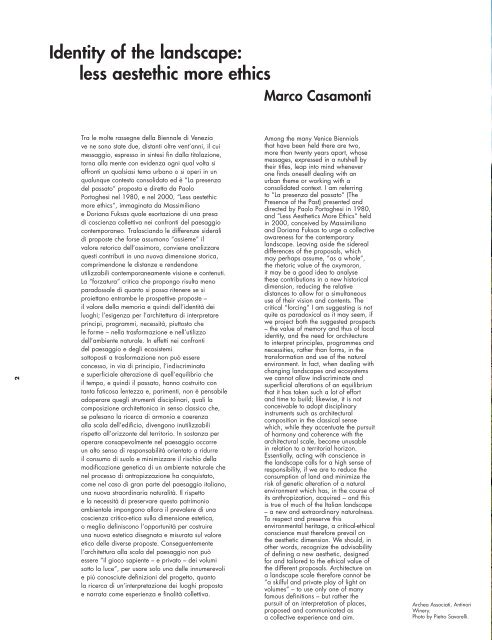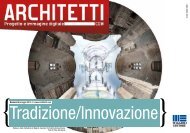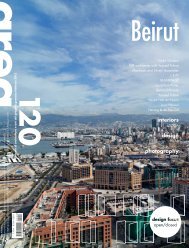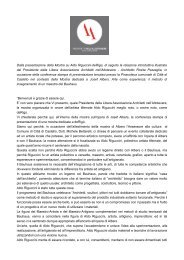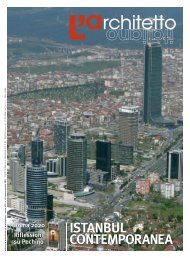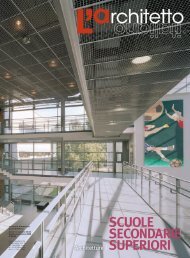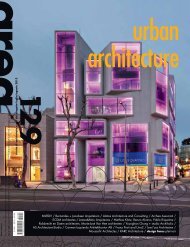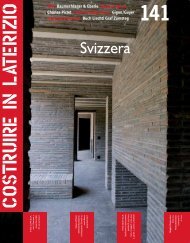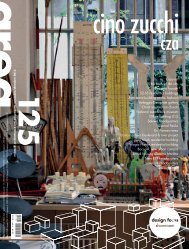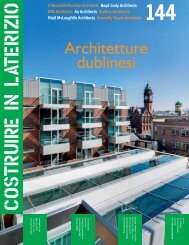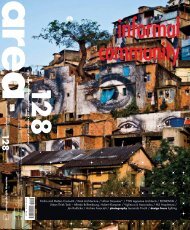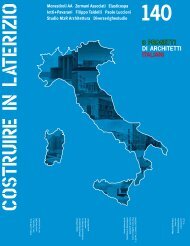Download AREA 127 - Architetti nell'Altotevere Libera Associazione
Download AREA 127 - Architetti nell'Altotevere Libera Associazione
Download AREA 127 - Architetti nell'Altotevere Libera Associazione
- No tags were found...
You also want an ePaper? Increase the reach of your titles
YUMPU automatically turns print PDFs into web optimized ePapers that Google loves.
2Identity of the landscape:less aestethic more ethicsMarco CasamontiTra le molte rassegne della Biennale di Veneziave ne sono state due, distanti oltre vent’anni, il cuimessaggio, espresso in sintesi fin dalla titolazione,torna alla mente con evidenza ogni qual volta siaffronti un qualsiasi tema urbano o si operi in unqualunque contesto consolidato ed è “La presenzadel passato“ proposta e diretta da PaoloPortoghesi nel 1980, e nel 2000, “Less aestethicmore ethics“, immaginata da Massimilianoe Doriana Fuksas quale esortazione di una presadi coscienza collettiva nei confronti del paesaggiocontemporaneo. Tralasciando le differenze sideralidi proposte che forse assumono “assieme” ilvalore retorico dell’ossimoro, conviene analizzarequesti contributi in una nuova dimensione storica,comprimendone le distanze e rendendoneutilizzabili contemporaneamente visione e contenuti.La “forzatura” critica che propongo risulta menoparadossale di quanto si possa ritenere se siproiettano entrambe le prospettive proposte –il valore della memoria e quindi dell’identità deiluoghi; l’esigenza per l’architettura di interpretareprincipi, programmi, necessità, piuttosto chele forme – nella trasformazione e nell’utilizzodell’ambiente naturale. In effetti nei confrontidel paesaggio e degli ecosistemisottoposti a trasformazione non può essereconcesso, in via di principio, l’indiscriminatae superficiale alterazione di quell’equilibrio cheil tempo, e quindi il passato, hanno costruito contanta faticosa lentezza e, parimenti, non è pensabileadoperare quegli strumenti disciplinari, quali lacomposizione architettonica in senso classico che,se palesano la ricerca di armonia e coerenzaalla scala dell’edificio, divengono inutilizzabilirispetto all’orizzonte del territorio. In sostanza peroperare consapevolmente nel paesaggio occorreun alto senso di responsabilità orientato a ridurreil consumo di suolo e minimizzare il rischio dellamodificazione genetica di un ambiente naturale chenel processo di antropizzazione ha conquistato,come nel caso di gran parte del paesaggio italiano,una nuova straordinaria naturalità. Il rispettoe la necessità di preservare questo patrimonioambientale impongono allora il prevalere di unacoscienza critico-etica sulla dimensione estetica,o meglio definiscono l’opportunità per costruireuna nuova estetica disegnata e misurata sul valoreetico delle diverse proposte. Conseguentementel’architettura alla scala del paesaggio non puòessere “il gioco sapiente – e privato – dei volumisotto la luce”, per usare solo una delle innumerevolie più conosciute definizioni del progetto, quantola ricerca di un’interpretazione dei luoghi propostae narrata come esperienza e finalità collettiva.Among the many Venice Biennialsthat have been held there are two,more than twenty years apart, whosemessages, expressed in a nutshell bytheir titles, leap into mind wheneverone finds oneself dealing with anurban theme or working with aconsolidated context. I am referringto “La presenza del passato“ (ThePresence of the Past) presented anddirected by Paolo Portoghesi in 1980,and “Less Aesthetics More Ethics“ heldin 2000, conceived by Massimilianoand Doriana Fuksas to urge a collectiveawareness for the contemporarylandscape. Leaving aside the siderealdifferences of the proposals, whichmay perhaps assume, “as a whole”,the rhetoric value of the oxymoron,it may be a good idea to analysethese contributions in a new historicaldimension, reducing the relativedistances to allow for a simultaneoususe of their vision and contents. Thecritical “forcing” I am suggesting is notquite as paradoxical as it may seem, ifwe project both the suggested prospects– the value of memory and thus of localidentity, and the need for architectureto interpret principles, programmes andnecessities, rather than forms, in thetransformation and use of the naturalenvironment. In fact, when dealing withchanging landscapes and ecosystemswe cannot allow indiscriminate andsuperficial alterations of an equilibriumthat it has taken such a lot of effortand time to build; likewise, it is notconceivable to adopt disciplinaryinstruments such as architecturalcomposition in the classical sensewhich, while they accentuate the pursuitof harmony and coherence with thearchitectural scale, become unusablein relation to a territorial horizon.Essentially, acting with conscience inthe landscape calls for a high sense ofresponsibility, if we are to reduce theconsumption of land and minimize therisk of genetic alteration of a naturalenvironment which has, in the course ofits anthropization, acquired – and thisis true of much of the Italian landscape– a new and extraordinary naturalness.To respect and preserve thisenvironmental heritage, a critical-ethicalconscience must therefore prevail onthe aesthetic dimension. We should, inother words, recognize the advisabilityof defining a new aesthetic, designedfor and tailored to the ethical value ofthe different proposals. Architecture ona landscape scale therefore cannot be“a skilful and private play of light onvolumes” – to use only one of manyfamous definitions – but rather thepursuit of an interpretation of places,proposed and communicated asa collective experience and aim.Archea Associati, AntinoriWinery.Photo by Pietro Savorelli.


